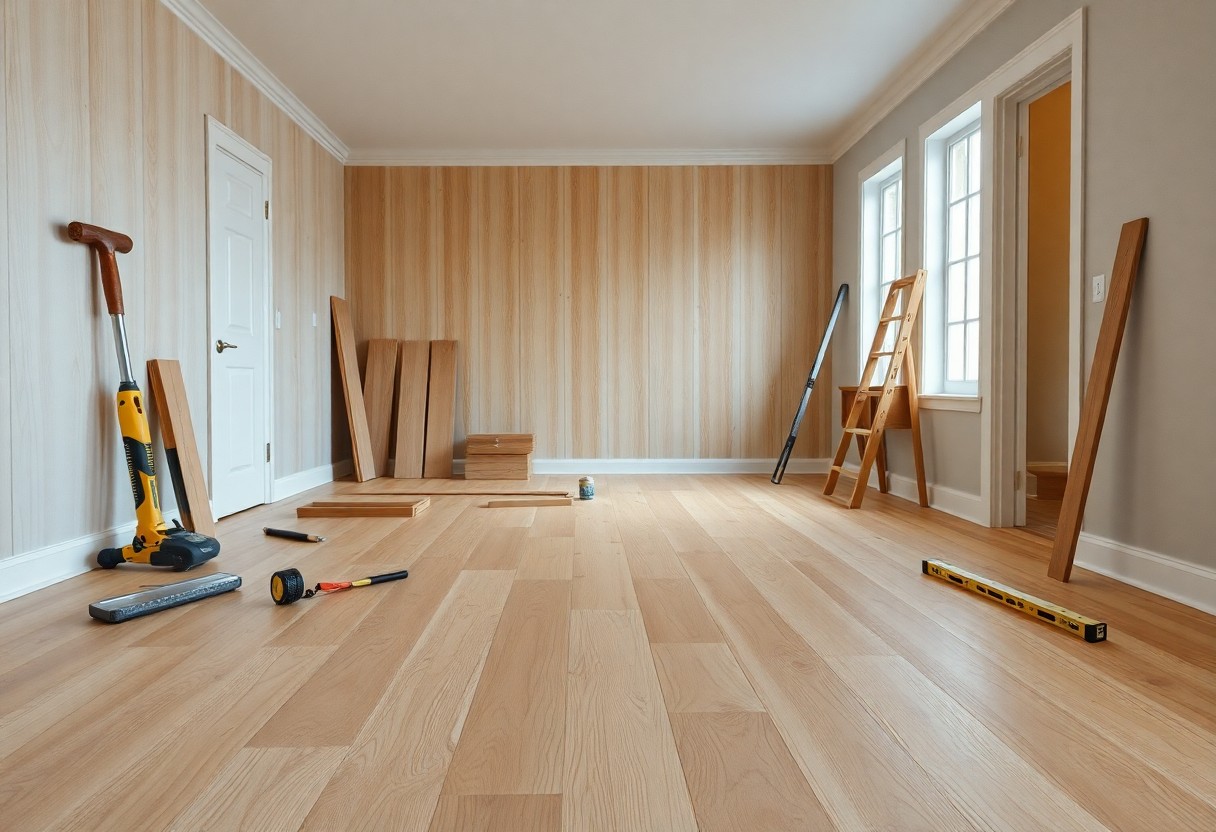There’s nothing quite like the elegance of white oak flooring to enhance the beauty of your home. In this comprehensive guide, you’ll learn how to install this stunning flooring type with confidence and ease. From selecting the right materials to ensuring proper installation techniques, each step will empower you to achieve professional results. With the right tools and guidance, you can transform your space into a warm and inviting haven that showcases the natural beauty of white oak.
Preparing Your Space for Installation
Preparing your space is important for a smooth white oak flooring installation. Begin by clearing the area of furniture, rugs, and other items to create an open workspace. Ensure all surfaces are clean and free from dust or debris, as this will help with the overall adhesion and stability of your new flooring. Identifying any potential obstacles beforehand will streamline the installation process and minimize disruptions.
Assessing Subfloor Conditions
Check the subfloor for any damage or irregularities. A flat, dry, and clean subfloor is key to a successful flooring installation. Use a level to identify any high or low areas and make necessary repairs. Moisture can also be detrimental; testing the subfloor’s humidity levels ensures a stable foundation for your white oak flooring.
Acclimating Your White Oak Flooring
Acclimating your white oak flooring involves allowing it to adjust to your home’s temperature and humidity levels before installation. This process typically takes 48 to 72 hours and is vital for preventing potential shifts or warping post-installation. Place the unopened boxes of flooring in the room where they will be installed, keeping them elevated to avoid moisture contact with the ground. Monitoring conditions, such as maintaining a consistent temperature of around 60-80°F and humidity levels between 30-50%, during this period will ensure your flooring performs optimally once installed.
Tools and Materials: Your Essential Arsenal
Your installation success heavily relies on the right tools and materials. Gathering a well-rounded assortment of the necessary instruments beforehand will streamline your workflow and ensure you achieve high-quality results. Having everything at your fingertips allows you to focus on laying down that stunning white oak flooring efficiently and effectively.
Must-Have Tools for Installation
A reliable set of tools will greatly enhance your installation process. Essential items include a miter saw, a flooring nailer or stapler, a measuring tape, a chalk line for straight layouts, and various hand tools like a pry bar and a hammer. Safety gear should be part of your arsenal too—goggles and knee pads will help protect you during installation.
Selecting Quality Materials and Equipment
Opting for top-notch materials can differentiate your project from the rest. Choose high-grade white oak planks that are kiln-dried to minimize expansion and contraction post-installation. Additionally, ensure you have quality underlayment, which contributes to noise reduction and moisture protection, prolonging the lifespan of your beautiful flooring.
High-quality white oak planks not only provide a stunning aesthetic but also promise enhanced durability and stability in various conditions. Look for flooring that meets industry standards, such as those certified by the Forest Stewardship Council (FSC). Investing in premium underlayment, preferably one with included vapor barriers, can dramatically improve soundproofing and moisture resistance—key factors in maintaining your flooring’s integrity over the years. Each choice, from the wood to the underlayment, affects the overall success of your installation project, so choosing wisely is necessary for a lasting finish.
Mastering the Layout: Planning Your Installation
Your floor layout plays a pivotal role in the overall aesthetics and functionality of your space. Prior to any installation, take the time to envision how the planks will flow throughout the room. Consider the grain direction, light sources, and transitions with adjacent spaces to create a harmonious look. Marking out the installation path will help you determine how to start and proceed efficiently, ensuring you minimize waste and enhance visual appeal throughout the entire flooring project.
Creating a Detailed Floor Plan
A detailed floor plan acts as your blueprint, simplifying the installation process and guiding your decisions along the way. Begin by measuring your room’s dimensions and charting them on graph paper or using digital design tools. Indicate doorways, closets, and any built-in features that might affect the layout. Consider how each board will be cut and laid out during installation, avoiding small, awkward pieces for a cleaner finish and maximizing the beauty of your white oak flooring.
Accounting for Expansion Gaps
Account for expansion gaps around the perimeter of your flooring, as wood naturally expands and contracts with changes in humidity and temperature. A gap of approximately 1/4 inch is recommended between the planks and walls to allow for this movement, preventing buckling or warping down the line. Use spacers along the edges during installation to maintain this gap, ensuring your beautiful new flooring remains intact and looks fantastic for years to come.
Expanding on the importance of accounting for these gaps, take into consideration the climate of your area and the specific conditions of the room. In warmer and more humid environments, you may want to increase the gap slightly to accommodate more significant expansion. Keeping a consistent distance will keep your flooring stable and prevent future issues like cracking or gaps between boards. Additionally, baseboards or quarter rounds can cover these gaps, offering a polished look while ensuring your flooring remains unimpeded by seasonal changes.
The Installation Process: Step-by-Step Guide
| Step | Description |
| 1. Acclimation | Allow your white oak flooring to acclimate in your home for 48 to 72 hours. |
| 2. Prepare Subfloor | Ensure your subfloor is clean, dry, and level. Address any imperfections. |
| 3. Lay Underlayment | Install moisture barrier and underlayment as per manufacturer specifications. |
| 4. Laying the First Rows | Start laying the first row of planks, ensuring they are straight and properly aligned. |
| 5. Continue Installing | Follow with subsequent rows, staggering joints for a seamless look. |
| 6. Final Touches | Install baseboards and trim to complete your new flooring. |
Laying the First Rows
Initiate the installation by positioning the first row of white oak planks against your chosen starting wall. Ensure the boards are straight and level, using spacers to maintain an expansion gap along the wall. Anchoring this first row firmly is vital, as it sets the foundation for the remaining rows and affects the overall alignment.
Techniques for Seamless Installation
Utilize staggered joints while laying your white oak flooring to enhance both durability and appearance. Aim for each subsequent row to meet the previous one with minimal gaps by carefully selecting board lengths. This technique avoids the appearance of a repetitive pattern, creating a more natural flow throughout the space.
This technique serves not only aesthetic purposes but also functional ones. Staggering the joints by a minimum of 6 inches among rows distributes weight evenly and reduces the chances of movement or squeaking over time. Consider using a combination of long and short planks to further enhance the look, blending the different lengths for an organic feel while maintaining structural integrity. Select boards that mimic the natural grain and color variations of white oak to achieve a beautifully cohesive yet unique floor finish.

Finishing Touches: Enhancing Durability and Beauty
Your newly installed white oak flooring deserves the best care to ensure it lasts and looks stunning for years to come. By applying the right finishes and sealants, you not only add to the aesthetic appeal but also increase resistance to scratches, stains, and moisture. Transitioning from raw wood to a beautifully finished surface can transform your space, providing a polished look that complements any decor.
Applying Finish and Sealants
Maintenance Tips for Long-Lasting Floors
- Wipe up spills immediately to prevent staining or warping.
- Place felt pads under furniture to avoid scratches.
- Use area rugs in high-traffic zones for added protection.
- Check humidity levels and maintain between 30% to 50% to prevent warping.
- Consider using a humidifier in winter months to maintain moisture.
- Inspect floors regularly for signs of damage and address promptly.
To wrap up
Drawing together the steps outlined above, you now have a clear framework for successfully installing white oak flooring in your space. By carefully preparing your subfloor, choosing the right installation method, and ensuring proper acclimation of the wood, you can achieve a beautiful and lasting result. Your attention to detail and adherence to these guidelines will help your new flooring enhance the aesthetic and value of your home for years to come.


